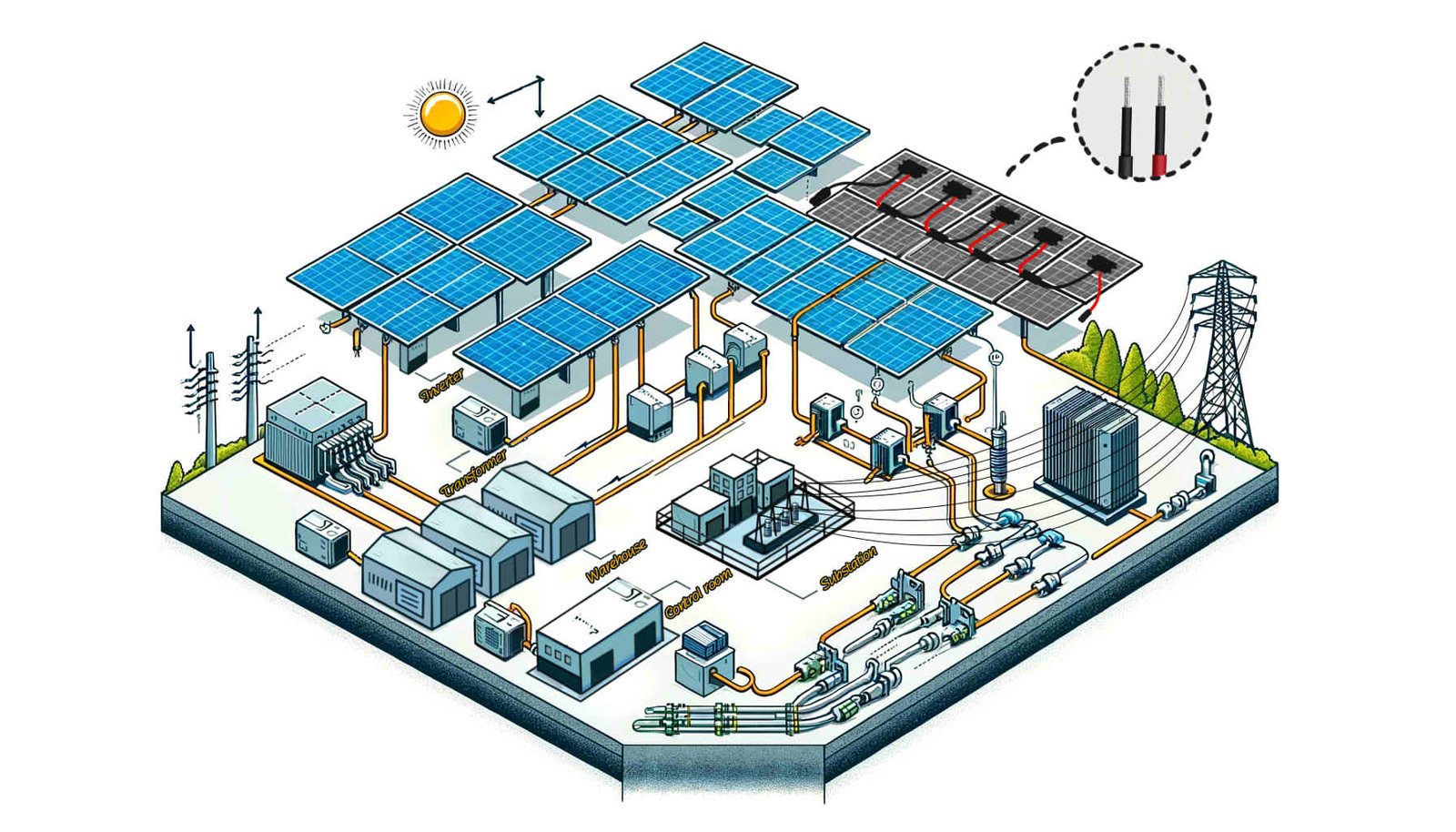ในขณะที่โลกเปลี่ยนไปสู่พลังงานทดแทน, พลังงานแสงอาทิตย์ได้กลายเป็นหนึ่งในแหล่งพลังงานไฟฟ้าที่ได้รับความนิยมและยั่งยืนที่สุด. โครงการพลังงานแสงอาทิตย์, ไม่ว่าจะเป็นที่อยู่อาศัยหรือเชิงพาณิชย์, ต้องมีการวางแผนและการพิจารณาอย่างรอบคอบ, โดยเฉพาะอย่างยิ่งเมื่อต้องเลือกส่วนประกอบที่เหมาะสม. ในบรรดาส่วนประกอบเหล่านี้, สายเคเบิลมีบทบาทสำคัญในการรับประกันประสิทธิภาพ, ความปลอดภัย, และอายุยืนยาวของระบบพลังงานแสงอาทิตย์.
สารบัญ
- กระบวนการผลิตไฟฟ้าระบบพลังงานแสงอาทิตย์
- จำเป็นต้องใช้สายเคเบิลประเภทใดสำหรับระบบพลังงานแสงอาทิตย์?
- เปอร์เซ็นต์ของต้นทุนการก่อสร้างทั้งหมดที่สายเคเบิลแสดงอยู่ในสถานีไฟฟ้าโซลาร์เซลล์?
- เกี่ยวกับสายไฟ DC พลังงานแสงอาทิตย์
- เหตุใดจึงต้องใช้สายเคเบิลพิเศษสำหรับระบบไฟฟ้าโซลาร์เซลล์?
- การรับรองTÜVสำหรับสายเคเบิลพลังงานแสงอาทิตย์คืออะไร?
- ควรเลือกข้อมูลจำเพาะใดสำหรับสาย PV H1Z2Z2-K?
- อะไรคือความแตกต่างระหว่างการใช้งาน DC และ AC ของสายเคเบิลไฟฟ้าโซลาร์เซลล์ H1Z2Z2-K?
- อะไรคือความแตกต่างระหว่างสายเคเบิลไฟฟ้าโซลาร์เซลล์ H1Z2Z2-K และ PV1-F?
- วิธีการเลือกข้อมูลจำเพาะของสายเคเบิล PV1-F?
- เหตุใดสายเคเบิลพลังงานแสงอาทิตย์จึงแยกเป็นสีแดงและสีดำ?
- คุณสามารถสร้างตัวเชื่อมต่อสายเคเบิลพลังงานแสงอาทิตย์ได้ด้วยตัวเองหรือไม่?
- ตัวเชื่อมต่อพลังงานแสงอาทิตย์ที่ใช้กันทั่วไปคืออะไร?
- เกี่ยวกับสายไฟ AC พลังงานแสงอาทิตย์
- เกี่ยวกับสายเคเบิลสำหรับระบบสายดิน
- เหตุใดระบบผลิตไฟฟ้าพลังงานแสงอาทิตย์จึงควรต่อสายดิน?
- สิ่งที่จำเป็นต้องมีการต่อสายดินในระบบพลังงานแสงอาทิตย์?
- แผงโซลาร์เซลล์มีการต่อสายดินอย่างไร?
- เหตุใดจึงควรเชื่อมต่อและต่อสายดินเฟรมของแผงโซลาร์เซลล์?
- วัสดุใดควรใช้สำหรับสายดินในระบบไฟฟ้าโซลาร์เซลล์?
- ข้อมูลจำเพาะของ Earth Rods ที่ใช้กันทั่วไปคืออะไร?
- ควรติดตั้ง Earth Rods ในระบบไฟฟ้าโซลาร์เซลล์อย่างไร?
- สายเคเบิลเหนือศีรษะ, สายควบคุมและสายสื่อสารในโครงการ PV
- ข้อกำหนดทางกฎหมายและข้อบังคับสำหรับการเดินสายเคเบิลในโครงการพลังงานแสงอาทิตย์
- แนวทางปฏิบัติที่ดีที่สุดสำหรับการกำหนดเส้นทางสายเคเบิล
- คำแนะนำที่จำเป็นสำหรับการซื้อสายเคเบิล
- ความคิดสุดท้าย
การเลือกสายเคเบิลที่เหมาะสมสำหรับโครงการพลังงานแสงอาทิตย์ของคุณอาจเป็นงานที่น่ากังวล, เนื่องจากมีตัวเลือกที่หลากหลายและข้อกำหนดเฉพาะของระบบไฟฟ้าโซลาร์เซลล์ (พีวี) ระบบ. คู่มือนี้มีจุดมุ่งหมายเพื่อให้ภาพรวมที่ครอบคลุมของทุกสิ่งที่คุณจำเป็นต้องรู้เกี่ยวกับการซื้อสายเคเบิลสำหรับโครงการพลังงานแสงอาทิตย์ของคุณ. จากการทำความเข้าใจกระบวนการผลิตพลังงานแสงอาทิตย์ไปจนถึงการเลือกประเภทสายเคเบิลที่เหมาะสมสำหรับการใช้งานที่แตกต่างกัน, เราจะครอบคลุมประเด็นสำคัญทั้งหมดเพื่อช่วยคุณในการตัดสินใจอย่างมีข้อมูล.
ในตอนท้ายของคู่มือนี้, คุณจะมีความเข้าใจที่ชัดเจนเกี่ยวกับปัจจัยสำคัญที่ต้องพิจารณาเมื่อซื้อสายเคเบิลสำหรับโครงการพลังงานแสงอาทิตย์ของคุณ, รับรองว่าระบบของคุณทำงานอย่างมีประสิทธิภาพและปลอดภัยในปีต่อๆ ไป.
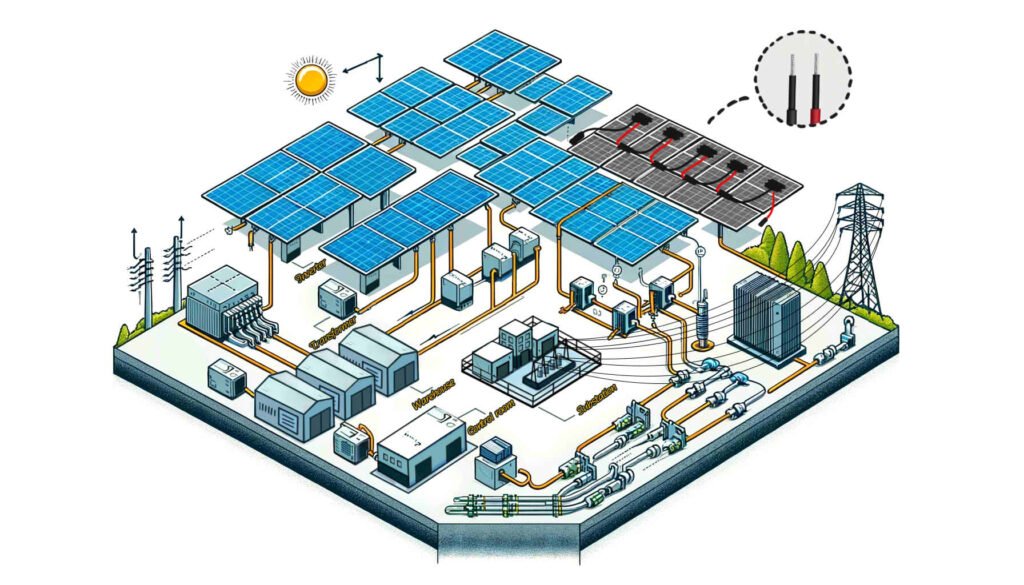
กระบวนการผลิตไฟฟ้าระบบพลังงานแสงอาทิตย์
การทำความเข้าใจกระบวนการผลิตไฟฟ้าจากระบบพลังงานแสงอาทิตย์เป็นสิ่งสำคัญในการเลือกสายเคเบิลและส่วนประกอบที่เหมาะสมสำหรับโครงการ PV ของคุณ. การเลือกสายเคเบิลที่เหมาะสมช่วยให้มั่นใจได้ถึงการส่งกระแสไฟฟ้าที่มีประสิทธิภาพและปลอดภัยทั่วทั้งระบบ, ไม่ว่าจะเป็นการตั้งค่าที่เชื่อมต่อกับกริดหรือนอกกริด.
1. แผงโซลาร์เซลล์จับแสงแดด
แผงเซลล์แสงอาทิตย์, ประกอบด้วยเซลล์แสงอาทิตย์จำนวนมาก, จับแสงอาทิตย์เมื่อโฟตอน (อนุภาคแสง) กระแทกพื้นผิว. โฟตอนเหล่านี้ถ่ายโอนพลังงานไปยังอิเล็กตรอนภายในเซลล์แสงอาทิตย์, สร้างกระแสไฟฟ้า.
2. การผลิตไฟฟ้า
พลังงานจากโฟตอนจะให้พลังงานแก่อิเล็กตรอน, ทำให้เกิดกระแสไหลและเกิดกระแสตรง (ดี.ซี). โดยทั่วไปแผงโซลาร์เซลล์จะถูกจัดเรียงเป็นอาร์เรย์ขนาดใหญ่เพื่อผลิตกระแสไฟฟ้าจำนวนมาก, เพียงพอต่อการจ่ายไฟให้กับบ้านเรือน, ธุรกิจ, หรือชุมชนทั้งหมด.
3. การแปลงอินเวอร์เตอร์
กระแสไฟฟ้ากระแสตรงที่สร้างโดยแผงโซลาร์เซลล์ไม่สามารถใช้กับเครื่องใช้ในครัวเรือนและอุปกรณ์เชิงพาณิชย์ส่วนใหญ่ได้โดยตรง, ซึ่งทำงานด้วยไฟฟ้ากระแสสลับ (เครื่องปรับอากาศ). เพื่อลดช่องว่างนี้, อินเวอร์เตอร์ใช้ในการแปลงไฟฟ้ากระแสตรงเป็นไฟฟ้ากระแสสลับ, ทำให้สามารถใช้งานร่วมกับระบบไฟฟ้ามาตรฐานได้.
4. การส่งและการกระจายสินค้า
หลังจากแปลงเป็นเอซีแล้ว, ไฟฟ้าจะถูกส่งไปยังหม้อแปลงไฟฟ้า. หม้อแปลงไฟฟ้าจะเพิ่มแรงดันไฟฟ้า, ซึ่งช่วยให้สามารถส่งสัญญาณได้อย่างมีประสิทธิภาพในระยะทางไกลผ่านสายไฟ. จากนั้นไฟฟ้ากระแสสลับแรงดันสูงจะถูกแจกจ่ายผ่านโครงข่ายไฟฟ้าไปยังผู้บริโภคต่างๆ, รวมถึงบ้านและธุรกิจ.
ระบบเชื่อมต่อกริด
ในระบบที่เชื่อมต่อกับกริด, กระบวนการมีดังนี้:
- แผงเซลล์แสงอาทิตย์สร้างไฟ DC: แผงโซลาร์เซลล์จับแสงอาทิตย์และสร้างพลังงานไฟฟ้ากระแสตรง.
- อินเวอร์เตอร์แปลงเป็นไฟ AC: ไฟ DC จะถูกแปลงเป็นไฟ AC โดยอินเวอร์เตอร์.
- หม้อแปลงไฟฟ้าเพิ่มแรงดันไฟฟ้า: ถ้าจำเป็น, หม้อแปลงไฟฟ้าจะเพิ่มแรงดันไฟฟ้าเพื่อการส่งสัญญาณที่มีประสิทธิภาพ.
- การส่งสัญญาณไปยังกริด: ไฟฟ้ากระแสสลับจะถูกส่งผ่านสายเหนือศีรษะไปยังโครงข่าย.
ในระบบนี้, พลังงานไฟฟ้าจะถูกแปลงระหว่าง DC และ AC เพียงครั้งเดียวที่ขั้นตอนอินเวอร์เตอร์. หลังการแปลง, โดยไฟฟ้าจะถูกส่งและใช้ในรูปแบบไฟฟ้ากระแสสลับ.
ระบบออฟกริด
ในระบบนอกกริด, กระบวนการนี้แตกต่างออกไปเล็กน้อย:
- แผงเซลล์แสงอาทิตย์สร้างไฟ DC: แผงโซลาร์เซลล์จับแสงอาทิตย์และสร้างพลังงานไฟฟ้ากระแสตรง.
- อินเวอร์เตอร์แปลงเป็นไฟ AC: ไฟ DC จะถูกแปลงเป็นไฟ AC โดยอินเวอร์เตอร์.
- หม้อแปลงไฟฟ้าเพิ่มแรงดันไฟฟ้า: หากจำเป็น, หม้อแปลงไฟฟ้าจะเพิ่มแรงดันไฟฟ้า.
- การใช้งานหรือการจัดเก็บโดยตรง: สามารถเชื่อมต่อไฟ AC เข้ากับโครงข่ายของผู้ใช้โดยตรงเพื่อใช้งานได้ทันทีหรือเก็บไว้ในแบตเตอรี่เพื่อใช้ในภายหลัง.
ระบบนอกกริดอาศัยพื้นที่จัดเก็บแบตเตอรี่เพื่อให้แน่ใจว่ามีการจ่ายไฟอย่างต่อเนื่อง, แม้ว่าจะไม่มีแสงแดดก็ตาม, เช่นในเวลากลางคืนหรือวันที่มีเมฆมาก.
หลังจากทราบขั้นตอนการผลิตพลังงานแสงอาทิตย์แล้ว, เราสามารถกำหนดได้ว่าต้องใช้สายเคเบิลใดสำหรับทั้งระบบ.
จำเป็นต้องใช้สายเคเบิลประเภทใดสำหรับระบบพลังงานแสงอาทิตย์?
เป็นองค์ประกอบสำคัญของการแก้ปัญหาพลังงานที่ยั่งยืน, การทำงานที่ปลอดภัยและมีประสิทธิภาพของระบบผลิตพลังงานแสงอาทิตย์นั้นขึ้นอยู่กับการกำหนดค่าที่เหมาะสมและการใช้สายเคเบิลพิเศษต่างๆ. ประเภทของสายเคเบิลที่จำเป็นสำหรับระบบผลิตพลังงานแสงอาทิตย์มีดังต่อไปนี้:
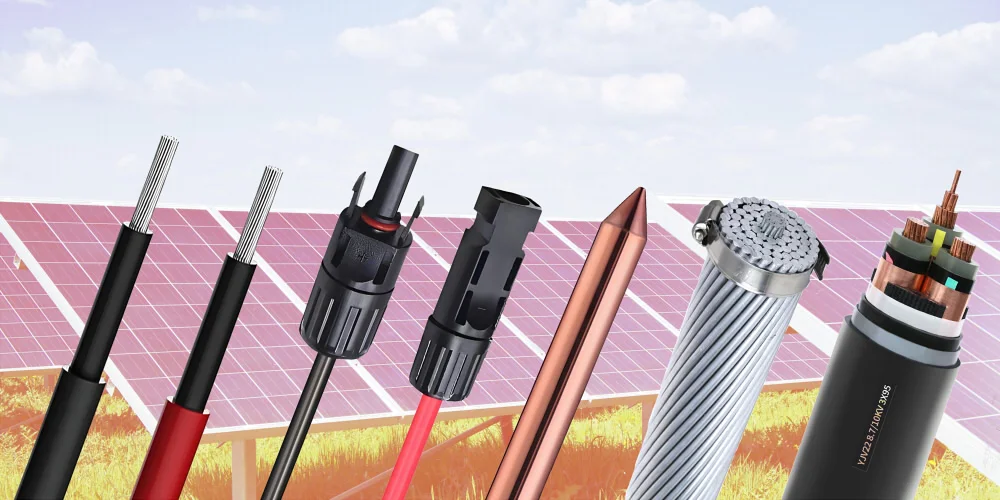
สายไฟ DC พลังงานแสงอาทิตย์
สายเคเบิลเหล่านี้ได้รับการออกแบบมาเป็นพิเศษสำหรับการเชื่อมต่อโมดูลไฟฟ้าโซลาร์เซลล์ (แผงเซลล์แสงอาทิตย์) และสำหรับการส่งกำลังระหว่างโมดูลไปยังกล่องรวม DC. เมื่อสัมผัสโดยตรงกับสภาพแวดล้อมภายนอก, ต้องมีคุณสมบัติดังต่อไปนี้:
- ต้านทานรังสียูวี: เพื่อป้องกันประสิทธิภาพเสื่อมลงเนื่องจากการโดนแสงแดดเป็นเวลานาน.
- ทนต่อสภาพอากาศ: เพื่อทนทานต่อสภาพอากาศต่างๆ, รวมถึงอุณหภูมิที่สูงมาก, ความชื้น, และทรายที่ถูกลมพัด.
- ความต้านทานการกัดกร่อนของสเปรย์เกลือ: เหมาะสำหรับพื้นที่ชายฝั่งทะเลเพื่อป้องกันความเสียหายจากเกลือ.
- สารหน่วงไฟ: เพื่อลดความเสี่ยงจากอัคคีภัยและเพิ่มความปลอดภัยให้กับระบบ.
- ความแข็งแรงทางกล: เพื่อทนทานต่อการติดตั้งและแรงกดดันต่อสิ่งแวดล้อมโดยไม่เกิดความเสียหายได้ง่าย.
สายไฟ AC
สายไฟ AC ถูกใช้ที่ปลายเอาต์พุตของอินเวอร์เตอร์เพื่อส่งไฟ AC ที่แปลงแล้วไปยังแผงจ่ายไฟ AC หรือไปยังโครงข่ายโดยตรง. สายเคเบิลเหล่านี้จำเป็นต้องเป็นไปตามมาตรฐานการเชื่อมต่อโครงข่ายและมีคุณสมบัติเป็นฉนวนที่ดีและทนความร้อนเพื่อให้มั่นใจในการส่งผ่านพลังงานที่ปลอดภัยและมีประสิทธิภาพ.
สายเคเบิลสื่อสารข้อมูล
ในระบบผลิตไฟฟ้าพลังงานแสงอาทิตย์, สายสื่อสารข้อมูลทำหน้าที่เป็นสะพานข้อมูล. พวกเขาไม่เพียงส่งข้อมูลไฟฟ้าที่สร้างโดยแผงเซลล์แสงอาทิตย์เท่านั้น แต่ยังส่งข้อมูลสถานะแบบเรียลไทม์ของอินเวอร์เตอร์และอุปกรณ์ตรวจสอบอื่น ๆ ไปยังระบบตรวจสอบส่วนกลางผ่านเครือข่ายแบบมีสายหรือไร้สาย (รวมถึงใยแก้วนำแสง) สำหรับการเพิ่มประสิทธิภาพระบบและการวินิจฉัยข้อผิดพลาด.
สายควบคุม
สายควบคุมใช้สำหรับเชื่อมต่อคอนโทรลเลอร์, อินเวอร์เตอร์, และอุปกรณ์เสริมอื่นๆภายในระบบ, รับประกันการควบคุมอัตโนมัติและการตรวจสอบที่มีประสิทธิภาพ. สายเคเบิลเหล่านี้ต้องมีความเสถียรในการส่งสัญญาณที่ดีและมีความสามารถในการป้องกันการรบกวนเพื่อให้แน่ใจว่าการดำเนินการคำสั่งควบคุมมีความแม่นยำ.
สายดิน
สายดินมีบทบาทสำคัญในการปกป้องความปลอดภัยของระบบผลิตพลังงานแสงอาทิตย์ทั้งหมด. เป็นเส้นทางที่มีความต้านทานต่ำเพื่อคายประจุกระแสฟ้าผ่าหรือกระแสขัดข้องของระบบอย่างรวดเร็ว, ป้องกันไฟฟ้าช็อตและความเสียหายของอุปกรณ์, จึงมั่นใจในความปลอดภัยของบุคลากรและอุปกรณ์.
สายเคเบิลเหนือศีรษะ
ในบางสถานการณ์การติดตั้ง, เช่นการส่งสัญญาณทางไกลหรือข้อจำกัดของภูมิประเทศ, สายเคเบิลเหนือศีรษะใช้สำหรับเชื่อมต่อโครงข่ายของระบบผลิตไฟฟ้าพลังงานแสงอาทิตย์. สายเคเบิลเหล่านี้จำเป็นต้องได้รับการออกแบบมาเป็นพิเศษเพื่อต้านทานความเสียหายทางกายภาพภายนอกและปัจจัยทางสภาพอากาศ ขณะเดียวกันก็รักษาค่าการนำไฟฟ้าและความแข็งแรงทางกลที่ดี.
เมื่อเลือกสายไฟแสงอาทิตย์เหล่านี้, ไม่เพียงแต่จะต้องคำนึงถึงคุณลักษณะและสภาพแวดล้อมที่เกี่ยวข้องเท่านั้น แต่ยังต้องแน่ใจว่าสายเคเบิลและอุปกรณ์เสริมทั้งหมดเป็นไปตามมาตรฐานความปลอดภัยทางไฟฟ้าในท้องถิ่นและข้อบังคับทางอุตสาหกรรม เพื่อให้มั่นใจถึงการทำงานที่มั่นคงในระยะยาวและการปฏิบัติตามระบบการผลิตพลังงานแสงอาทิตย์.
เปอร์เซ็นต์ของต้นทุนการก่อสร้างทั้งหมดที่สายเคเบิลแสดงอยู่ในสถานีไฟฟ้าโซลาร์เซลล์?
ต้นทุนของสายเคเบิลในแผงเซลล์แสงอาทิตย์ (พีวี) โดยทั่วไปแล้วโรงไฟฟ้าจะเป็นตัวแทนของบริเวณโดยรอบ 10% ของต้นทุนการก่อสร้างทั้งหมด. เปอร์เซ็นต์นี้อาจแตกต่างกันไปขึ้นอยู่กับปัจจัยหลายประการ เช่น ขนาดของโครงการ, การเลือกอุปกรณ์, ความแตกต่างในระดับภูมิภาค, และความผันผวนของตลาด. ตามการประมาณการบางประการ:
- โมดูลไฟฟ้าโซลาร์เซลล์ (แผงเซลล์แสงอาทิตย์) คิดเป็นประมาณ 50% ของต้นทุนอุปกรณ์ทั้งหมด.
- อินเวอร์เตอร์และอุปกรณ์ไฟฟ้าอื่นๆ ประมาณนี้ 10%.
- สายเคเบิลและโครงสร้างการติดตั้งแต่ละอย่างมีความหมายประมาณ 10%.
ดังนั้น, ค่าใช้จ่ายของสายเคเบิลโดยทั่วไปประกอบด้วย 10% ของต้นทุนการก่อสร้างทั้งหมด. อย่างไรก็ตาม, นี่เป็นการประมาณการคร่าวๆ, และสัดส่วนที่แท้จริงอาจแตกต่างกันไปขึ้นอยู่กับงบประมาณและราคาวัสดุเฉพาะของโครงการ. นอกจากนี้, ด้วยความก้าวหน้าทางเทคโนโลยีและการเปลี่ยนแปลงของตลาด, เปอร์เซ็นต์นี้อาจต้องมีการปรับเปลี่ยน.
เกี่ยวกับสายไฟ DC พลังงานแสงอาทิตย์
เหตุใดจึงต้องใช้สายเคเบิลพิเศษสำหรับระบบไฟฟ้าโซลาร์เซลล์?
สายเคเบิลไฟฟ้าโซลาร์เซลล์ได้รับการออกแบบมาเป็นพิเศษสำหรับโครงการผลิตไฟฟ้าโซลาร์เซลล์, มีลักษณะเป็นฉนวนและเปลือกหุ้มที่สายไฟธรรมดาไม่มี.
หากใช้สายเคเบิลธรรมดาในระบบ PV, พวกเขามีแนวโน้มที่จะล้มเหลวในสภาพแวดล้อมกลางแจ้งที่รุนแรง, ลดอายุการใช้งานของระบบพลังงานแสงอาทิตย์ทั้งหมดได้อย่างมาก. นอกจากนี้, อาจทำให้กระแสไฟเกินได้, แรงดันไฟฟ้าตกอย่างรุนแรง, ข้อผิดพลาดในการสร้างบ่อยครั้ง, และประสิทธิภาพการผลิตไฟฟ้าต่ำในโรงไฟฟ้าพลังงานแสงอาทิตย์, อาจทำให้เกิดเพลิงไหม้ในโรงงานได้.
ดังนั้น, เพื่อให้มั่นใจว่าโรงไฟฟ้าพลังงานแสงอาทิตย์มีการดำเนินงานที่มั่นคงในระยะยาว 25 ปี, จำเป็นต้องเลือกสายเคเบิลที่ออกแบบมาสำหรับระบบไฟฟ้าโซลาร์เซลล์โดยเฉพาะ, เช่น H1Z2Z2-K หรือ PV1-F.
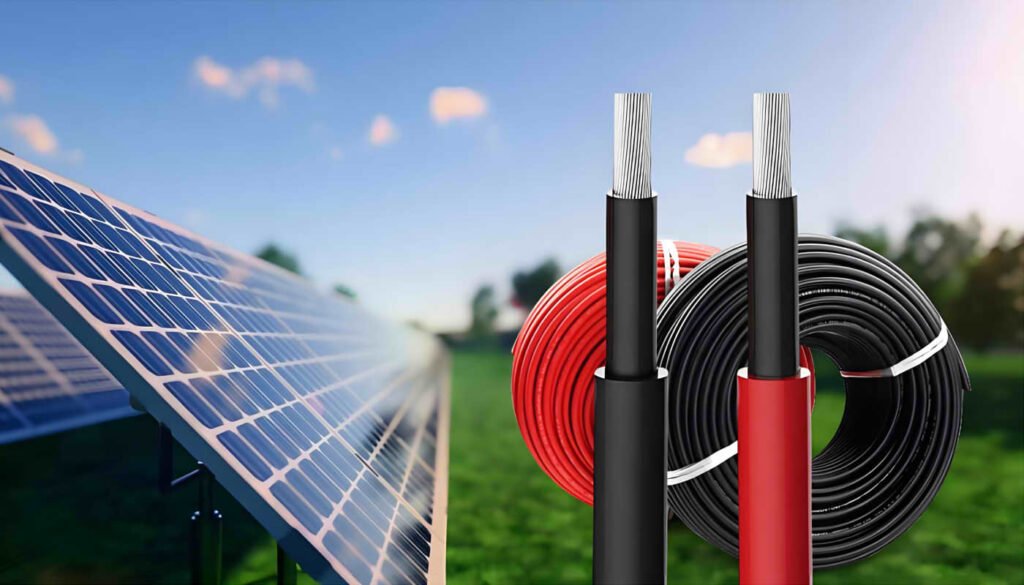
การรับรองTÜVสำหรับสายเคเบิลพลังงานแสงอาทิตย์คืออะไร?
TÜV Solar Cable Certification หมายถึงชุดใบรับรองที่มอบให้กับสายเคเบิลที่ได้รับการทดสอบ, ตรวจสอบและรับรองโดยบุคคลที่สามอิสระของ TÜV Rheinland Group, มีสำนักงานใหญ่ในประเทศเยอรมนี, ตามมาตรฐานเฉพาะ.
เป็นสายไฟชนิดพิเศษ, ความปลอดภัยและประสิทธิภาพของสายเคเบิลไฟฟ้าโซลาร์เซลล์มีความสำคัญอย่างยิ่งต่อระบบผลิตพลังงานแสงอาทิตย์, ด้วยเหตุนี้พวกเขาจึงผ่านการทดสอบและการรับรองอย่างเข้มงวดเพื่อให้มั่นใจในคุณภาพและความน่าเชื่อถือ.
เกี่ยวกับการรับรอง TÜV สำหรับสายเคเบิล PV, การพัฒนาก้าวหน้าไปจาก 2PfG 1169/08.2007 มาตรฐาน EN 50618:2014 มาตรฐาน. มาตรฐานล่าสุดคือ IEC FDIS 62930, แต่การรับรองสายเคเบิลพลังงานแสงอาทิตย์ส่วนใหญ่ยังคงยึดตาม EN ที่ถูกต้อง 50618 มาตรฐาน.
ควรเลือกข้อมูลจำเพาะใดสำหรับสาย PV H1Z2Z2-K?
ในระบบไฟฟ้าโซลาร์เซลล์ทั่วไป, ตัวเลือกที่พบบ่อยที่สุดคือ H1Z2Z2-K 1×4 และ H1Z2Z2-K 1×6 สายเคเบิล. โดยทั่วไป, ส่วนตัดขวางของสายเคเบิลที่ใหญ่ขึ้นบ่งบอกถึงความสามารถในการรับน้ำหนักที่มากขึ้น.
ข้อควรพิจารณาเช่นแรงดันไฟฟ้าในการทำงาน, ความจุปัจจุบัน, และควรคำนึงถึงช่วงอุณหภูมิสิ่งแวดล้อมด้วย. หลังจากกำหนดข้อกำหนดด้านแรงดันและกระแสแล้ว, โปรดดูตารางพารามิเตอร์ของสายเคเบิล H1Z2Z2-K เพื่อเลือกข้อกำหนดที่เหมาะสม.
หากคุณพบความไม่แน่นอนในการเลือกข้อมูลจำเพาะของสายเคเบิล, ทีมเทคนิค ZMS ของเราพร้อมนำเสนอโซลูชันที่ปรับให้เหมาะสม.
เรียนรู้เพิ่มเติมเกี่ยวกับ สายไฟโซล่าเซลล์ H1Z2Z2-K
อะไรคือความแตกต่างระหว่างการใช้งาน DC และ AC ของสายเคเบิลไฟฟ้าโซลาร์เซลล์ H1Z2Z2-K?
สาย H1Z2Z2-K ใช้ได้กับทั้งวงจร DC (1.5กิโลโวลต์) และวงจรไฟฟ้ากระแสสลับ (1.0/1.0กิโลโวลต์). ในระบบผลิตไฟฟ้าโซลาร์เซลล์, ความแตกต่างในการใช้งานเฉพาะมีดังนี้:
สำหรับการใช้งาน DC:
- การเชื่อมต่อแบบอนุกรมระหว่างโมดูลไฟฟ้าโซลาร์เซลล์
- การเชื่อมต่อแบบขนานระหว่างสายอักขระ
- การเชื่อมต่อแบบขนานจากสตริงไปยังกล่องกระจาย DC
- การเชื่อมต่อจากกล่องจ่ายไฟ DC ไปยังอินเวอร์เตอร์
สำหรับการใช้งาน AC:
- การเชื่อมต่อจากอินเวอร์เตอร์ไปยังหม้อแปลงสเต็ปอัพ
- การเชื่อมต่อจากหม้อแปลงแบบสเต็ปอัพไปยังอุปกรณ์จำหน่าย
- การเชื่อมต่อจากอุปกรณ์กระจายไปยังกริดหรือผู้ใช้
อะไรคือความแตกต่างระหว่างสายเคเบิลไฟฟ้าโซลาร์เซลล์ H1Z2Z2-K และ PV1-F?
สายเคเบิล PV1-F เป็นสายเคเบิลพลังงานแสงอาทิตย์รุ่นเก่าที่เป็นไปตามมาตรฐาน TÜV 2Pfg1169, และการรับรองมาตรฐานได้หยุดการอัปเดตแล้ว. ในทางตรงกันข้าม, สายเคเบิลไฟฟ้าโซลาร์เซลล์ H1Z2Z2-K เป็นไปตามมาตรฐาน TÜV EN50618 ล่าสุด:2014 การรับรอง.
อัตราแรงดันไฟฟ้าจะแตกต่างกันระหว่างสายเคเบิล PV1-F และ H1Z2Z2-K. PV1-F มีพิกัดแรงดันไฟฟ้าที่ DC: 1.0กิโลโวลต์และไฟฟ้ากระแสสลับ: ยูโอ/ยู: 0.6/1.0กิโลโวลต์, ในขณะที่ H1Z2Z2-K มีพิกัดแรงดันไฟฟ้าที่ DC: 1.5กิโลโวลต์และไฟฟ้ากระแสสลับ: ยูโอ/ยู: 1.0/1.0กิโลโวลต์. H1Z2Z2-K สามารถให้ประสิทธิภาพและความเสถียรในการส่งข้อมูลที่สูงขึ้น.
ในส่วนของโครงสร้าง, สายเคเบิล PV1-F มีชั้นฉนวนชั้นเดียว, ในขณะที่สายเคเบิล H1Z2Z2-K ใช้โครงสร้างฉนวนสองชั้น. ทำให้สายเคเบิล H1Z2Z2-K เหนือกว่าในด้านความทนทานและการป้องกัน, โดยเฉพาะอย่างยิ่งต่อความเสียหายทางกลและปัจจัยด้านสิ่งแวดล้อม.
โดยสรุป, สายเคเบิลพลังงานแสงอาทิตย์ H1Z2Z2-K มีการออกแบบที่ล้ำหน้ากว่า, ให้ประสิทธิภาพทางไฟฟ้าและเครื่องกลที่สูงขึ้น, เหมาะสำหรับสภาพแวดล้อมการใช้งานที่มีความต้องการมากขึ้น. ในทางกลับกัน, สายเคเบิลพลังงานแสงอาทิตย์ PV1-F มีข้อได้เปรียบหลักในด้านความคุ้มค่า, เหมาะสำหรับระบบไฟฟ้าโซลาร์เซลล์ทั่วไปส่วนใหญ่.
เพื่อการพิจารณาความคุ้มค่า, สายเคเบิล PV1-F สามารถใช้สำหรับการเชื่อมต่อแบบอนุกรมระหว่างโมดูลไฟฟ้าโซลาร์เซลล์และการเชื่อมต่อแบบขนานจากสายอักขระไปยังกล่องกระจายไฟ DC. ขณะเดียวกัน, สามารถใช้สายเคเบิล H1Z2Z2-K สำหรับการเชื่อมต่อระหว่างกล่องกระจายสัญญาณและอินเวอร์เตอร์, ตลอดจนการเชื่อมต่อไฟฟ้ากระแสตรงในอินเวอร์เตอร์ขนาดใหญ่.
วิธีการเลือกข้อมูลจำเพาะของสายเคเบิล PV1-F?
ตอนนี้, สายไฟ DC ที่ใช้กันมากที่สุดคือ PV1-F 1×4 สายเคเบิล. อย่างไรก็ตาม, ด้วยการเพิ่มขึ้นของกระแสโมดูลเซลล์แสงอาทิตย์และกำลังอินเวอร์เตอร์เดี่ยว, การประยุกต์ใช้ PV1-F 1×6 สายไฟ DC ก็เพิ่มขึ้นเช่นกัน.
ตามข้อกำหนดที่เกี่ยวข้อง, ขอแนะนำโดยทั่วไปว่าการสูญเสียสายไฟ DC ของเซลล์แสงอาทิตย์ไม่ควรเกิน 2%. ในวงจรไฟฟ้ากระแสตรง, ความต้านทานสายของสายเคเบิล PV1-F 1x4 มม.² คือ 4.6 ม./ม, และความต้านทานสายของสายเคเบิล PV1-F 1x6 มม.² คือ 3.1 ม./ม. สมมติว่าแรงดันไฟฟ้าทำงาน 600V สำหรับโมดูล DC, ก 2% การสูญเสียแรงดันไฟฟ้าตกคือ 12V. สมมติว่ากระแสโมดูลอยู่ที่ 13A, เมื่อใช้สายไฟ DC ขนาด 4 มม.², ระยะทางสูงสุดที่แนะนำจากปลายโมดูลที่ไกลที่สุดถึงอินเวอร์เตอร์ไม่ควรเกิน 120 เมตร (สายเดี่ยว, ไม่รวมขั้วบวกและขั้วลบ). ถ้าเกินระยะนี้., ขอแนะนำให้เลือกสายไฟ DC ขนาด 6 มม.², แต่ระยะห่างสูงสุดที่แนะนำจากปลายโมดูลที่ไกลที่สุดถึงอินเวอร์เตอร์ไม่ควรเกิน 170 เมตร.
เพื่อลดต้นทุนของระบบ, โรงไฟฟ้าพลังงานแสงอาทิตย์ในปัจจุบันไม่ค่อยกำหนดค่าโมดูลและอินเวอร์เตอร์ใน 1:1 อัตราส่วน. แทน, พวกเขาออกแบบปริมาณความจุส่วนเกินโดยพิจารณาจากปัจจัยต่างๆ เช่น สภาพแสงแดดและข้อกำหนดของโครงการ. ตัวอย่างเช่น, สำหรับโมดูล 110KW, เลือกอินเวอร์เตอร์ขนาด 100KW, และคำนวณจากความจุเกิน 1.1 เท่าบนฝั่งไฟฟ้ากระแสสลับของอินเวอร์เตอร์. กระแสไฟขาออก AC สูงสุดคือประมาณ 158A. สายไฟ AC จะถูกเลือกตามกระแสเอาต์พุตสูงสุดของอินเวอร์เตอร์. เพราะไม่ว่าโมดูลจะกำหนดค่าเกินจำนวนเท่าใด, กระแสอินพุต AC ของอินเวอร์เตอร์จะไม่เกินกระแสเอาต์พุตสูงสุดของอินเวอร์เตอร์.
เรียนรู้เพิ่มเติมเกี่ยวกับ สายเคเบิลพลังงานแสงอาทิตย์ PV1-F
เหตุใดสายเคเบิลพลังงานแสงอาทิตย์จึงแยกเป็นสีแดงและสีดำ?
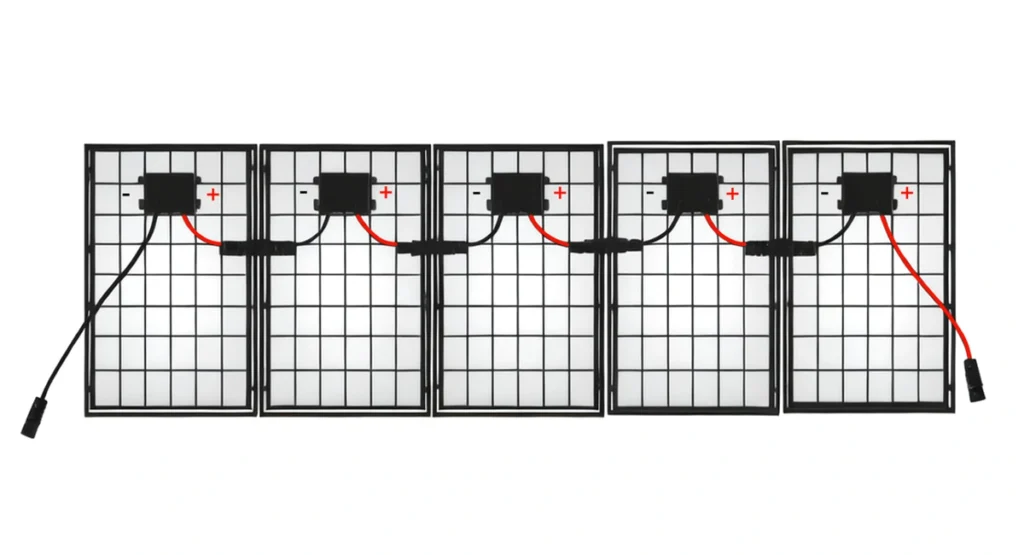
ในอุตสาหกรรมเซลล์แสงอาทิตย์, การใช้สายเคเบิลสีแดงและสีดำได้กลายเป็นวิธีการระบุตัวตนที่ได้รับการยอมรับอย่างกว้างขวาง. จุดประสงค์หลักคือเพื่อแยกความแตกต่างระหว่างขั้วบวกและขั้วลบ. ในวงจรไฟฟ้ากระแสตรง, โดยทั่วไป, สายแสงอาทิตย์สีแดงแสดงถึงขั้วบวกของกระแสไฟ, ในขณะที่สายแสงอาทิตย์สีดำแสดงถึงขั้วลบ. การแยกสีนี้ช่วยให้ระบุขั้วของการเชื่อมต่อไฟฟ้าโซลาร์เซลล์ได้อย่างรวดเร็วระหว่างการติดตั้งและบำรุงรักษาระบบสุริยะ, จึงป้องกันข้อผิดพลาดในการเดินสายไฟ.
คุณสามารถสร้างตัวเชื่อมต่อสายเคเบิลพลังงานแสงอาทิตย์ได้ด้วยตัวเองหรือไม่?
กระบวนการทำขั้วต่อสายพลังงานแสงอาทิตย์รวมถึงการตรวจสอบความเสียหายของแกนและหัวตัวผู้และตัวเมีย, และใช้เครื่องปอกสายไฟ, เครื่องมือการจีบ, และประแจปลายเปิด. แม้แต่ผู้ที่ไม่ใช่มืออาชีพก็สามารถสร้างตัวเชื่อมต่อเหล่านี้ได้โดยทำตามขั้นตอนเฉพาะ.
เมื่อเทียบกับการทำคอนเน็คเตอร์ด้วยตัวเอง, การปรับแต่งสายต่อขยายแผงโซลาร์เซลล์โดยตรงอาจมีราคาแพงกว่าเล็กน้อย, แต่สามารถประหยัดเวลาและแรงงานและทำให้การติดตั้งสะดวกยิ่งขึ้น.
ตัวเชื่อมต่อพลังงานแสงอาทิตย์ที่ใช้กันทั่วไปคืออะไร?
ประเภทตัวเชื่อมต่อที่ใช้กันมากที่สุดในระบบโซลาร์เซลล์แสงอาทิตย์คือตัวเชื่อมต่อ MC4. ได้กลายเป็นหนึ่งในมาตรฐานสำหรับตัวเชื่อมต่อไฟฟ้าโซลาร์เซลล์เนื่องจากมีการใช้งานอย่างแพร่หลายและเป็นที่ยอมรับของตลาด. สายต่อขยายคอนเนคเตอร์ MC4 สามารถทนต่อแรงดันไฟฟ้าและกระแสไฟฟ้าสูงและเหมาะสำหรับการเชื่อมต่อแผงโซลาร์เซลล์, อินเวอร์เตอร์, และส่วนประกอบของระบบอื่นๆ.
ตัวเชื่อมต่อที่เข้ากันได้กับ MC4 ของ ZMS นั้นสอดคล้องกับตัวเชื่อมต่อ MC4 ในข้อมูลจำเพาะ, ขนาด, และความอดทนและสามารถเป็นได้ 100% จับคู่.
นอกจากขั้วต่อ MC4 แล้ว, ขั้วต่อพลังงานแสงอาทิตย์ที่ใช้กันทั่วไปอื่น ๆ ได้แก่ ขั้วต่อชนิด Y หรือขั้วต่อแบบขนาน. โครงสร้างของพวกเขาคือตัวเชื่อมต่อแบบหนึ่งต่อกลุ่ม, ซึ่งสามารถเชื่อมต่อแผงโซลาร์เซลล์หลายแผงแบบอนุกรมเพื่อเพิ่มแรงดันไฟฟ้าของแผงโซลาร์เซลล์ทั้งหมดโดยยังคงรักษากระแสไฟให้คงที่.
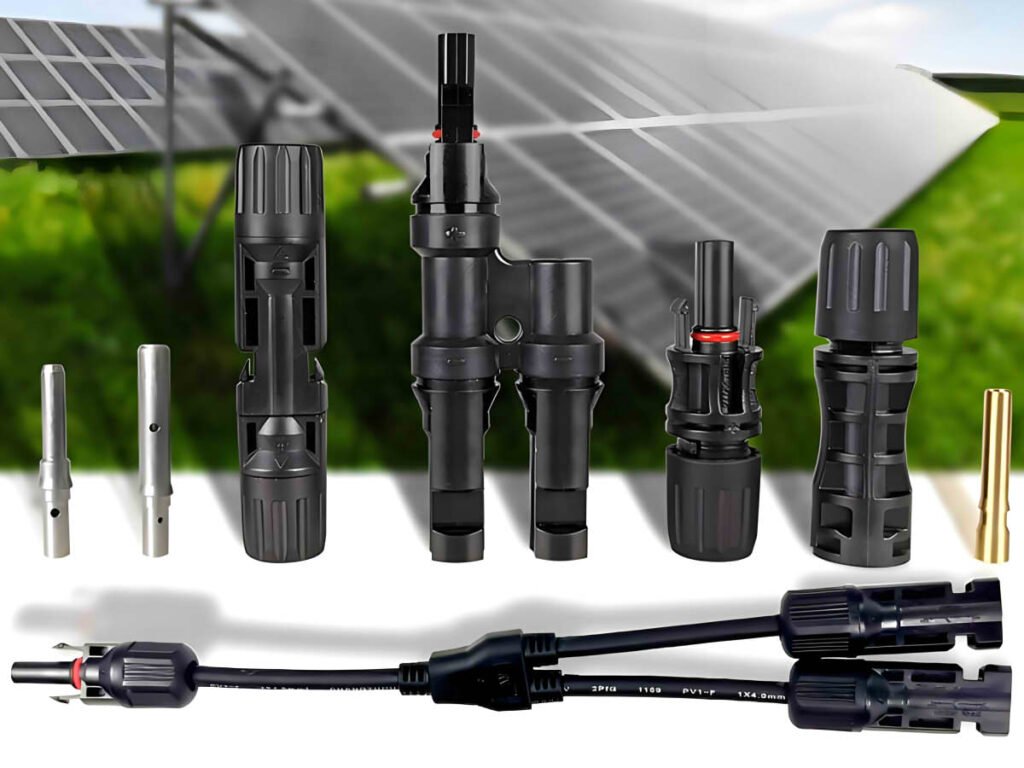
เรียนรู้เพิ่มเติมเกี่ยวกับ ขั้วต่อสายเคเบิลพลังงานแสงอาทิตย์
เกี่ยวกับสายไฟ AC พลังงานแสงอาทิตย์
ควรเลือกสายไฟ AC LV สำหรับโครงการพลังงานแสงอาทิตย์อย่างไร?
เมื่อสถานีพลังงานแสงอาทิตย์อยู่ใกล้กับโหลดเซ็นเตอร์หรือเป็นรุ่นแบบกระจาย, คุณเพียงต้องใช้สายเคเบิลแรงดันต่ำเพื่อเชื่อมต่อโดยตรงกับเครือข่ายการกระจายแรงดันต่ำ 3 เฟส 400V หรือ 230V เฟสเดียว. เพื่อเชื่อมต่อกับโครงข่ายไฟฟ้าแรงสูงหรือปานกลาง, ต้องใช้สายแรงดันต่ำเชื่อมต่อกับหม้อแปลงก่อน.
แรงดันไฟฟ้าขาออกของอินเวอร์เตอร์มักจะมีมาตรฐานต่างๆ กัน. ตัวอย่างเช่น, แรงดันเอาต์พุตของอินเวอร์เตอร์ส่วนกลางสามารถเป็น 315V, 360วี, 400วี, และอื่น ๆ, ในขณะที่แรงดันเอาต์พุตของสตริงอินเวอร์เตอร์สามารถเป็น 480V, 500วี, 540วี, 800วี, และอื่น ๆ.
ดังนั้น, ในระบบ PV, โดยทั่วไปคุณสามารถใช้สายเคเบิลแรงดันต่ำที่มีแรงดันไฟฟ้า 450/750V ได้, 0.6/1 กิโลโวลต์, หรือ 1.8/3 กิโลโวลต์. ขึ้นอยู่กับว่าสายฝังหรือเปล่า, สามารถเพิ่มชั้นเกราะได้.
เรียนรู้เพิ่มเติมเกี่ยวกับ สายไฟเอซีพลังงานแสงอาทิตย์
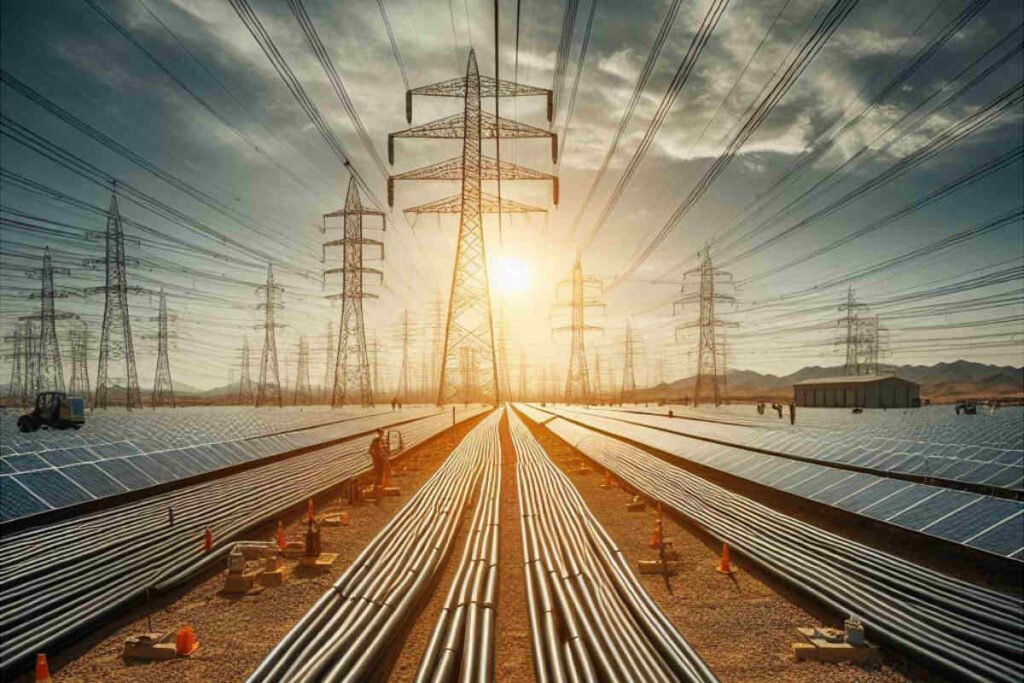
ควรเลือกสายไฟ AC MV สำหรับโครงการพลังงานแสงอาทิตย์อย่างไร?
หากระบบผลิตไฟฟ้าโซลาร์เซลล์จำเป็นต้องเชื่อมต่อกับโครงข่ายไฟฟ้าแรงกลางหรือแรงสูง, ต้องใช้สายแรงดันต่ำเชื่อมต่อกับหม้อแปลงก่อน, ซึ่งจะเพิ่มระดับแรงดันไฟฟ้าให้อยู่ในระดับที่เหมาะสม. จากนั้นจะใช้สายเคเบิลแรงดันปานกลางเพื่อจ่ายพลังงานให้กับสถานีย่อย. จำนวนสายเคเบิลแรงดันปานกลางที่ต้องการขึ้นอยู่กับวิธีการเชื่อมต่อ.
โครงสร้างดาวแบบดั้งเดิม
ในโครงสร้างดาวแบบดั้งเดิม, หม้อแปลงแต่ละตัวมีสายเอาต์พุตแรงดันไฟฟ้าปานกลางเส้นเดียวเชื่อมต่อกับสถานีย่อย. โครงสร้างนี้ง่ายและตรงไปตรงมาที่สุด, และมักใช้ในการออกแบบโรงไฟฟ้าพลังงานแสงอาทิตย์. สายเคเบิลแต่ละเส้นมีกำลังไฟเท่ากับหม้อแปลงเพียงตัวเดียวเท่านั้น, ดังนั้นข้อมูลจำเพาะของสายเคเบิลจึงเล็กลง, การลดต้นทุน. อย่างไรก็ตาม, เนื่องจากหม้อแปลงแต่ละตัวมีสายเชื่อมต่อกับสถานีไฟฟ้าย่อยเพียงสายเดียว, ความน่าเชื่อถือไม่สูงมาก.
โครงสร้างวงแหวนเอาต์พุตเดี่ยว
โครงสร้างวงแหวนเอาต์พุตเดี่ยวเชื่อมต่อหม้อแปลงหลายตัวในวงแหวนโดยใช้สายเคเบิล, และหม้อแปลงที่ใกล้กับสถานีย่อยที่สุดจะเชื่อมต่อกับสถานีย่อยโดยใช้สายเคเบิลแรงดันปานกลาง. เมื่อเทียบกับโครงสร้างวงแหวนเอาต์พุตคู่, โครงสร้างวงแหวนเอาต์พุตเดี่ยวใช้สายเคเบิลพลังงานแสงอาทิตย์ AC แรงดันปานกลางน้อยกว่า. อย่างไรก็ตาม, เพราะทั้งวงแหวนมีเพียงเส้นเดียวที่เชื่อมต่อกับสถานีย่อย, ความน่าเชื่อถือลดลง.
โครงสร้างวงแหวนเอาต์พุตคู่
โครงสร้างวงแหวนเอาต์พุตคู่มีสายเพิ่มเติมที่เชื่อมต่อวงแหวนกับสถานีย่อย เมื่อเปรียบเทียบกับโครงสร้างวงแหวนเอาต์พุตเดี่ยว. หากบรรทัดเอาต์พุตหนึ่งบรรทัดล้มเหลว, อีกสายหนึ่งสามารถอนุญาตให้อินเวอร์เตอร์ในวงแหวนส่งออกพลังงานไปยังโครงข่ายต่อไปได้. คล้ายกับโครงสร้างวงแหวนเอาต์พุตเดี่ยว, พิจารณาทิศทางการไหลระหว่างเกิดฟอลต์, ต้องเลือกสายทั้งหมดให้ทนทานต่อกำลังไฟของหม้อแปลงทั้งหมด, ส่งผลให้ต้นทุนค่อนข้างสูงขึ้น.
โครงสร้างสะพาน
ก่อนเสนอโครงสร้างวงแหวน, มักใช้โครงสร้างสะพาน. ในโครงสร้างนี้, ตามโครงสร้างของดวงดาว, หม้อแปลงที่อยู่ติดกันแต่ละคู่เชื่อมต่อกันโดยใช้สายเคเบิลแรงดันปานกลาง. ทางนี้, หม้อแปลงแต่ละตัวมีสองสายเชื่อมต่อกับสถานีย่อย, ปรับปรุงความน่าเชื่อถือของระบบอย่างมาก. อย่างไรก็ตาม, ต้นทุนค่อนข้างสูงเนื่องจากมีสายเพิ่มเติมระหว่างหม้อแปลงแต่ละคู่.
สำหรับโรงไฟฟ้าพลังงานแสงอาทิตย์ขนาดต่างๆ, การวิเคราะห์การเลือกสายเคเบิลจะแตกต่างกันไปตามข้อกำหนดที่แตกต่างกัน. เมื่อเลือกสายไฟแรงดันปานกลาง, การพิจารณาข้อกำหนดบังคับอย่างครอบคลุมเป็นสิ่งสำคัญ, ค่าใช้จ่าย, และผลประโยชน์เพื่อกำหนดแนวทางแก้ไขและการตัดสินใจที่ได้เปรียบที่สุด.
หลักการเลือกสายไฟ AC สำหรับระบบพลังงานแสงอาทิตย์มีอะไรบ้าง?
การเลือกสายไฟ AC สำหรับโครงการพลังงานแสงอาทิตย์เป็นไปตามข้อกำหนดทั่วไปในการเลือกสายไฟ, ซึ่งรวมถึงการพิจารณาระดับแรงดันไฟฟ้าด้วย, กระแสไฟทำงานต่อเนื่อง, เสถียรภาพทางความร้อนลัดวงจร, แรงดันไฟฟ้าตกที่อนุญาต, ความหนาแน่นทางเศรษฐกิจในปัจจุบัน, และสภาพแวดล้อมในการติดตั้ง. นอกจากนี้, การผลิตไฟฟ้าโซลาร์เซลล์มีลักษณะเฉพาะของตัวเอง, ต้องคำนึงถึงสายเคเบิลที่อาจใช้ในสภาพแวดล้อมที่รุนแรง เช่น อุณหภูมิสูง, หนาวจัด, และรังสีอัลตราไวโอเลต. ดังนั้น, ควรคำนึงถึงปัจจัยต่อไปนี้:
- ประสิทธิภาพของฉนวนของสายเคเบิล
- ทนความร้อนและหน่วงไฟของสายเคเบิล
- ทนต่อความชื้นและป้องกันรังสียูวีของสายเคเบิล
- วิธีการติดตั้งสายเคเบิล
- ประเภทของตัวนำสายเคเบิล
- ข้อมูลจำเพาะของสายเคเบิล
เกี่ยวกับสายเคเบิลสำหรับระบบสายดิน
เหตุใดระบบผลิตไฟฟ้าพลังงานแสงอาทิตย์จึงควรต่อสายดิน?
การต่อสายดินในระบบ PV ถือเป็นปัญหาหนึ่งที่เจ้าหน้าที่ติดตั้ง PV มักมองข้ามบ่อยที่สุด, โดยเฉพาะอย่างยิ่งในระบบ PV ที่มีความจุขนาดเล็กซึ่งการต่อสายดินและการป้องกันฟ้าผ่าไม่ได้รับความสนใจมากนัก.
อย่างไรก็ตาม, หากไม่ได้ต่อสายดิน, ข้อผิดพลาดอาจเกิดขึ้นได้เนื่องจากความต้านทานของฉนวนต่อกราวด์ต่ำหรือกระแสรั่วไหลมากเกินไป, ส่งผลกระทบต่อการผลิตไฟฟ้าและอาจเป็นอันตรายต่อความปลอดภัยส่วนบุคคล. นอกจากนี้, ชิ้นส่วนโลหะที่ไม่มีฉนวนหุ้มหรือยกสูงจะเสี่ยงต่อฟ้าผ่ามากกว่า. โดยไม่ต้องต่อสายดิน, อุปกรณ์อาจถูกฟ้าผ่าได้, ก่อให้เกิดความเสียหายอย่างสำคัญต่อระบบผลิตไฟฟ้าพลังงานแสงอาทิตย์.
การต่อสายดินในระบบ PV ส่วนใหญ่รวมถึงการต่อสายดินที่ด้านส่วนประกอบพลังงานแสงอาทิตย์, ด้านอินเวอร์เตอร์, และด้านตู้กระจายสินค้า. การต่อสายดินที่เหมาะสมไม่เพียงแต่ช่วยเพิ่มความปลอดภัยของระบบสุริยะเท่านั้น แต่ยังช่วยยืดอายุการใช้งานอีกด้วย.
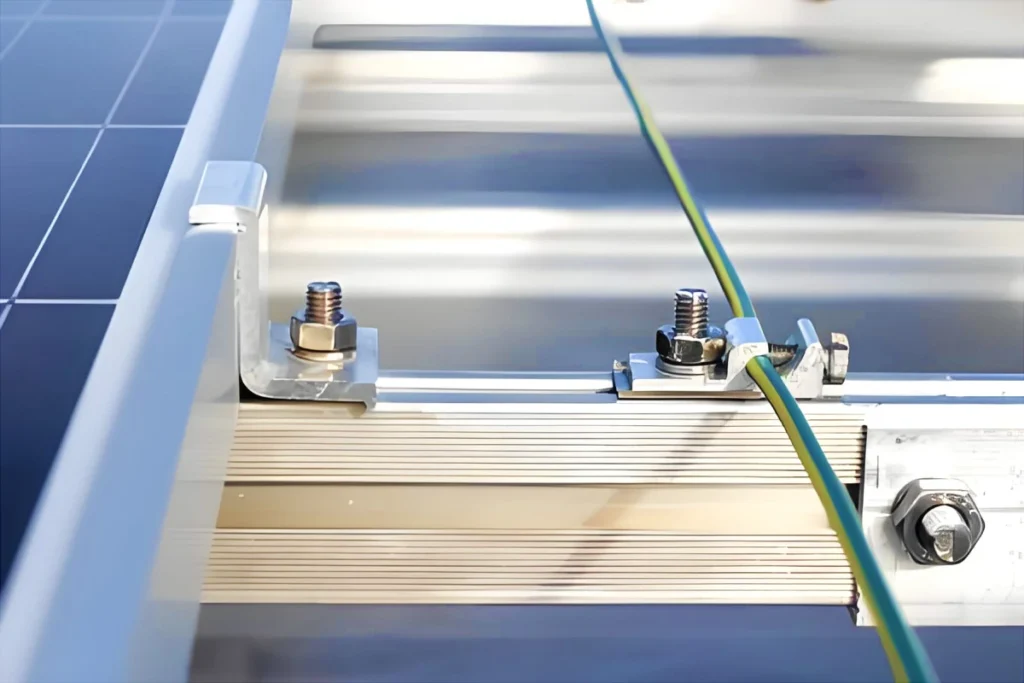
สิ่งที่จำเป็นต้องมีการต่อสายดินในระบบพลังงานแสงอาทิตย์?
การต่อสายดินด้านส่วนประกอบ:
- การต่อสายดินของเฟรมโมดูล: กรอบอะลูมิเนียมของโมดูลที่สัมผัสกับตัวยึดไม่ได้หมายถึงการต่อสายดินที่มีประสิทธิภาพ. รูกราวด์ของโมดูลจำเป็นต้องเชื่อมต่อเข้ากับตัวยึดเพื่อการกราวด์ที่มีประสิทธิภาพ. โดยทั่วไปแล้วรูกราวด์ของโมดูลจะใช้สำหรับการเชื่อมต่อแบบสตริง, โดยมีรูกราวด์ที่ปลายทั้งสองข้างเชื่อมต่อกับตัวยึดโลหะ.
- ติดสายดิน: โดยปกติ, เหล็กกลม, แท่งเหล็กชุบสังกะสี, หรือแท่งเหล็กเคลือบทองแดงใช้สำหรับต่อลงดิน, โดยต้องมีความต้านทานต่อสายดินไม่เกิน 4Ω.
การต่อสายดินด้านอินเวอร์เตอร์:
- การต่อลงดินในการปฏิบัติงาน: ขั้วต่อ PE ของอินเวอร์เตอร์เชื่อมต่อกับบัสบาร์ PE ในกล่องจ่ายไฟ, ซึ่งต่อสายดินผ่านกล่องกระจาย.
- สายดินป้องกัน: ช่องต่อสายดินของตัวเครื่องอินเวอร์เตอร์ใช้สำหรับการต่อสายดินซ้ำๆ เพื่อปกป้องอินเวอร์เตอร์และความปลอดภัยของผู้ปฏิบัติงาน. การต่อสายดินป้องกันของโครงเครื่องอินเวอร์เตอร์สามารถใช้อิเล็กโทรดสายดินแยกต่างหาก หรือใช้ร่วมกับกล่องจ่ายไฟก็ได้.
การต่อสายดินด้านกล่องกระจาย:
- สายดินป้องกันฟ้าผ่า: ระบบป้องกันฟ้าผ่าด้านไฟฟ้ากระแสสลับประกอบด้วยฟิวส์หรือเซอร์กิตเบรกเกอร์และอุปกรณ์ป้องกันไฟกระชาก (เอสพีดี). ปลายล่างของ SPD เชื่อมต่อกับบัสบาร์กราวด์ของกล่องจ่ายไฟ.
- การต่อสายดินของกล่อง: ตามข้อบังคับ, โครงโลหะและเหล็กฐานของกล่องกระจายสินค้าต้องต่อสายดินหรือต่อเข้ากับสายกลาง. ประตูตู้และตัวตู้จำเป็นต้องมีการเชื่อมต่อข้ามเพื่อให้แน่ใจว่ามีการต่อสายดินที่เชื่อถือได้.
แผงโซลาร์เซลล์มีการต่อสายดินอย่างไร?
โดยทั่วไป, รูกราวด์บนแผงโซลาร์เซลล์ใช้เพื่อเชื่อมต่อระหว่างสายของแผง. แผงที่ปลายทั้งสองด้านของเชือกเชื่อมต่อกับโครงโลหะ, ใช้สายดินสุริยะสีเหลืองเขียวเป็นหลัก.
สำหรับการต่อกราวด์กรอบแผง, โดยทั่วไปจะใช้แท่งเหล็กผูกมัดทองแดงขนาด φ10 หรือ φ12, ฝังอยู่ 1.5 เมตรใต้ดิน.
ความต้านทานต่อสายดินของแผงโซลาร์เซลล์ไม่ควรเกิน 4Ω. หากไม่เป็นไปตามข้อกำหนดด้านความต้านทานต่อสายดิน, มักจะเติมสารลดความต้านทาน, หรือแท่งกราวด์ฝังอยู่ในพื้นที่ที่มีความต้านทานต่อดินต่ำกว่า.
เรียนรู้เพิ่มเติมเกี่ยวกับ สายดินพลังงานแสงอาทิตย์
เหตุใดจึงควรเชื่อมต่อและต่อสายดินเฟรมของแผงโซลาร์เซลล์?
บางคนเชื่อว่าเนื่องจากทั้งแผงโซลาร์เซลล์และโครงสร้างรองรับเป็นโลหะ, การต่อสายดินรองรับเพียงอย่างเดียวก็เพียงพอแล้ว.
ในความเป็นจริง, กรอบอลูมิเนียมแผงโซลาร์เซลล์และส่วนรองรับโลหะผสมสังกะสีหรืออลูมิเนียมส่วนใหญ่ได้รับการเคลือบ, ซึ่งไม่เป็นไปตามข้อกำหนดด้านสายดิน. นอกจากนี้, แผงโซลาร์เซลล์อาจมีอายุมากขึ้นเมื่อเวลาผ่านไป, อาจนำไปสู่กระแสรั่วไหลมากเกินไปหรือความต้านทานของฉนวนกับพื้นต่ำ. หากกรอบแผงโซลาร์เซลล์ไม่ได้ต่อสายดิน, หลังจากใช้งานไประยะหนึ่ง, ซึ่งอาจส่งผลให้อินเวอร์เตอร์ขัดข้องได้, ทำให้ระบบ PV ไม่สามารถผลิตไฟฟ้าได้อย่างเหมาะสม.
เมื่อเชื่อมต่อโครงแผงโซลาร์เซลล์เข้ากับส่วนรองรับโลหะ, จำเป็นต้องถอดชั้นออกไซด์ออกจากพื้นผิวโลหะเพื่อลดความต้านทานต่อสายดิน, ตรวจสอบให้แน่ใจว่าเป็นไปตามข้อกำหนดด้านสายดิน.
วัสดุใดควรใช้สำหรับสายดินในระบบไฟฟ้าโซลาร์เซลล์?
เหล็กชุบสังกะสีมีราคาถูกกว่า, แต่มีรอยเชื่อมหลายจุด, ส่งผลให้ประสิทธิภาพการก่อสร้างลดลงและต้นทุนการก่อสร้างสูงขึ้น. ทองแดงบริสุทธิ์มีค่าการนำไฟฟ้าที่ดีเยี่ยมแต่มีราคาแพง. เหล็กเคลือบทองแดง, อย่างไรก็ตาม, ค่าใช้จ่ายเท่านั้น 9.4% มากกว่าเหล็กชุบสังกะสีและมีอายุการใช้งานยาวนานกว่ามาก. ดังนั้น, โดยทั่วไปแล้วแท่งกราวด์ไฟฟ้าที่ทำจากเหล็กเคลือบทองแดงมักถูกเลือกให้เป็นวัสดุกราวด์หลักในระบบพลังงานแสงอาทิตย์.
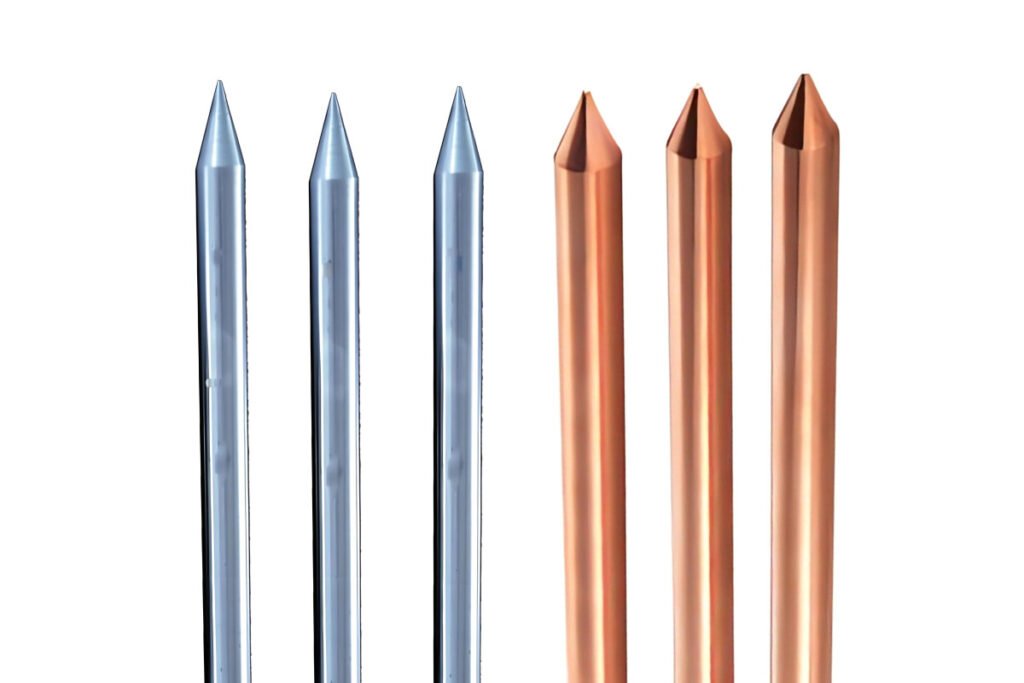
ข้อมูลจำเพาะของ Earth Rods ที่ใช้กันทั่วไปคืออะไร?
เหล็กเคลือบทองแดง
ในระบบไฟฟ้าโซลาร์เซลล์, ตัวกราวด์แนวนอนของวัสดุกราวด์เหล็กเคลือบทองแดงมักใช้เหล็กกลมเคลือบทองแดง Φ10-Φ12, โดยมีความยาวในการผลิตโดยทั่วไปคือ 100 เมตรต่อม้วน. อิเล็กโทรดกราวด์ใช้แท่งเหล็กเชื่อมทองแดง Φ14 หรือ Φ17.2.
วิธีการเชื่อมต่อ: การเชื่อมด้วยเทอร์ไมต์ (ไม่จำเป็นต้องใช้พลังงานจากภายนอกหรืออะเซทิลีน), โดยใช้ทองแดงบริสุทธิ์สำหรับวัสดุข้อต่อ, โดยไม่ต้องมีมาตรการป้องกันการกัดกร่อนที่จุดเชื่อม.
เหล็กชุบสังกะสี
ในกริดกราวด์แบบดั้งเดิม, โครงสร้างสายดินแนวนอนที่ทำจากเหล็กชุบสังกะสีแบบจุ่มร้อนโดยทั่วไปได้รับการออกแบบโดยมีข้อกำหนดของเหล็กแบนชุบสังกะสี 50X5 หรือ 60X6, โดยมีความยาวการผลิตอยู่ที่ 6 เมตรต่อชิ้น. อิเล็กโทรดกราวด์แนวตั้งใช้เหล็กฉากชุบสังกะสีแบบจุ่มร้อน 50X5 หรือท่อเหล็กชุบสังกะสี Φ50, โดยมีความยาวอิเล็กโทรดกราวด์เท่ากับ 2.5 เมตรต่อชิ้น.
วิธีการเชื่อมต่อ: การเชื่อมไฟฟ้า, โดยมีจุดเชื่อมที่ต้องการการป้องกันการกัดกร่อน, เช่น สีกันสนิม 2 ชั้น และสีแอสฟัลต์ 1 ชั้น.
ทองแดงเปลือย
สำหรับวัสดุสายดินทองแดงบริสุทธิ์, ตัวสายดินแนวนอนมักจะใช้ 25×4, 40×4, 50×5, หรือ 60×6 แถบทองแดง มม, หรือสายทองแดงเปลือย S70/S95/S120/S150/S185/S240 มม.. โดยทั่วไปแล้วตัวสายดินแนวตั้งจะใช้ 16×2500 มม. หรือ 20×2500 แท่งทองแดง มม, หรือ 50×3000 มม. หรือ 55×2500 มม. อิเล็กโทรดกราวด์อิเล็กโทรไลต์ไอออนทองแดงบริสุทธิ์.
วิธีการเชื่อมต่อ: การเชื่อมด้วยเทอร์ไมต์, การเชื่อมหลอมโคลนไฟ, หรือการเชื่อมแบบร้อนละลาย.
เรียนรู้เพิ่มเติมเกี่ยวกับ Earth Rod สำหรับระบบ PV
ควรติดตั้ง Earth Rods ในระบบไฟฟ้าโซลาร์เซลล์อย่างไร?
ระหว่างการก่อสร้าง, การติดตั้งสายกราวด์มีความยืดหยุ่นสูงและสามารถปรับให้เข้ากับเงื่อนไขเฉพาะที่ไซต์งานได้. สามารถใช้วิธีการต่างๆได้, เช่นการตอกแท่งกราวด์ไฟฟ้าลงดินโดยตรงด้วยค้อนหนักหรือค้อนไฟฟ้า. ในสภาพดินที่ซับซ้อนซึ่งไม่สามารถขับเคลื่อนก้านเข้าไปได้, สามารถเจาะรูก่อนติดตั้งคันดินได้.
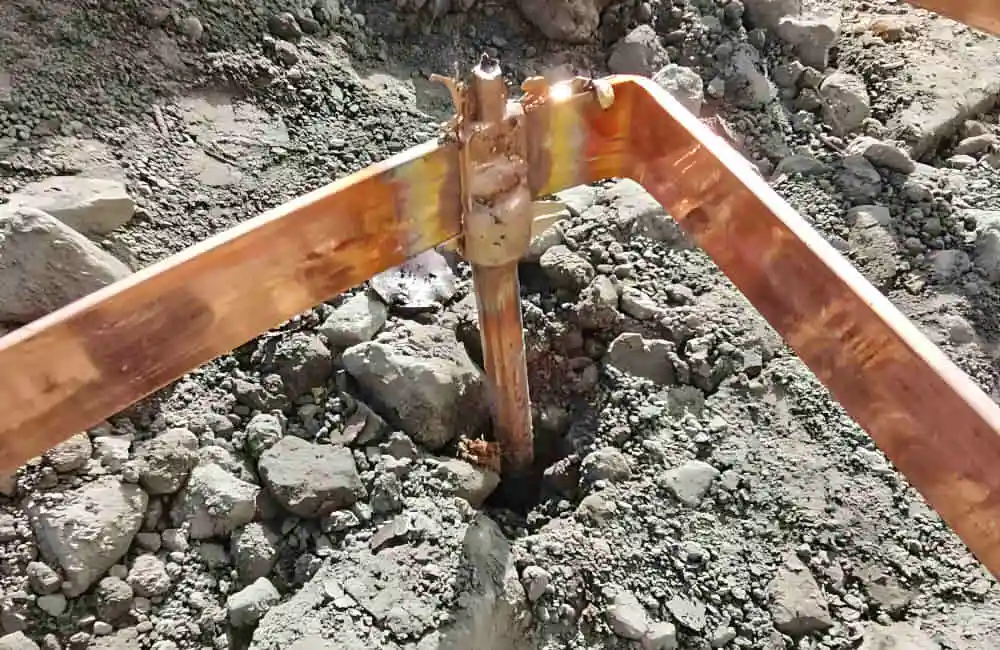
ในสภาพดินที่สม่ำเสมอ, หากใช้ค้อนทุบหนักในการติดตั้งและขับคันเดียว, ขอแนะนำให้ติดตั้งสว่าน (สลักเกลียวทนต่อแรงกระแทก) ที่ปลายแหลมของแท่งเพื่อป้องกันความเสียหายต่อชั้นทองแดงเมื่อตอกแท่งลึก. เพื่อการลงดินที่ลึกยิ่งขึ้น, สามารถเชื่อมต่อแท่งหลายอันได้โดยใช้ตัวเชื่อมต่อเพื่อให้ได้ความยาวตามที่ต้องการ, รับประกันการเชื่อมต่อไฟฟ้าที่ดี.
ในกรณีที่การเจาะลึกทำได้ยากหรือเป็นไปไม่ได้, เครื่องมือขุดเจาะสามารถใช้เจาะหินได้. หลังจากเจาะ, การติดตั้งสายดินมีสองวิธี:
- เชื่อมต่อแท่งตามความยาวที่ต้องการโดยใช้ขั้วต่อ. เมื่อเจาะได้ลึกตามที่ต้องการแล้ว, เติมรูด้วยสารลดความต้านทานและเติมน้ำจนเต็มรู.
- เชื่อมต่อแท่งตามความยาวที่ต้องการโดยใช้ขั้วต่อ. หลังจากเจาะได้ความลึกที่ต้องการแล้ว, ผสมสารลดความต้านทานกับน้ำแล้วเทลงในรูเพื่อห่อหุ้มก้านให้เต็ม.
สายเคเบิลเหนือศีรษะ, สายควบคุมและสายสื่อสารในโครงการ PV
สายไฟเหนือศีรษะใดที่จะใช้ในระบบพลังงานแสงอาทิตย์?
ในระบบผลิตไฟฟ้าโซลาร์เซลล์ที่เชื่อมต่อกับกริด, เมื่ออินเวอร์เตอร์แปลงไฟ DC ที่สร้างขึ้นเป็นไฟ AC และรวมเข้ากับโครงข่ายไฟฟ้ากระแสสลับ, การส่งกำลังมักดำเนินการผ่านสายเหนือศีรษะ. โดยทั่วไป, กระบวนการเชื่อมต่อโครงข่ายของระบบผลิตไฟฟ้าโซลาร์เซลล์สามารถเกิดขึ้นได้ในสถานการณ์ต่อไปนี้:
การเชื่อมต่อโดยตรง
สำหรับระบบผลิตไฟฟ้าโซลาร์เซลล์แบบกระจายขนาดเล็ก, เช่นแผงเซลล์แสงอาทิตย์บนหลังคาที่อยู่อาศัย, ไฟ DC สามารถแปลงเป็นไฟ AC ได้โดยตรงผ่านอินเวอร์เตอร์ จากนั้นเชื่อมต่อกับโครงข่ายไฟฟ้าแรงต่ำผ่านสายจำหน่าย. ในกรณีนี้, สามารถใช้สายเคเบิลแรงดันต่ำใต้ดินและสายเคเบิลหุ้มฉนวนเหนือศีรษะ เช่น สาย ABC ได้.
การเชื่อมต่อผ่าน Box Transformers หรือการรวมสถานีย่อย
สถานีไฟฟ้าโซลาร์เซลล์ขนาดกลางหรือเชิงพาณิชย์อาจใช้สถานีไฟฟ้าย่อยแบบกล่อง (หม้อแปลงกล่อง) เพื่อแปลงไฟ DC ที่สร้างขึ้นเป็นไฟ AC เหมาะสำหรับการรวมโครงข่ายผ่านอินเวอร์เตอร์, จากนั้นเพิ่มแรงดันไฟฟ้าผ่านหม้อแปลงกล่องให้ตรงกับระดับแรงดันไฟฟ้าของโครงข่ายเหนือศีรษะ, ก่อนที่จะเชื่อมต่อกับสายเหนือศีรษะ.
โรงไฟฟ้าพลังงานแสงอาทิตย์แบบติดตั้งภาคพื้นดินขนาดใหญ่มักต้องใช้หม้อแปลงไฟฟ้าเพื่อเพิ่มแรงดันไฟฟ้าให้สูงขึ้นเพื่อการส่งสัญญาณที่มีประสิทธิภาพ. ในกรณีนี้, กำลังไฟฟ้าเชื่อมต่อโดยตรงกับสถานีย่อย, ซึ่งจะกระจายไปยังโครงข่ายไฟฟ้าแรงสูงหรือไฟฟ้าแรงสูงพิเศษ.
ในสองสถานการณ์นี้, หากระยะทางจากสถานีไฟฟ้าถึงจุดเชื่อมต่อโครงข่ายค่อนข้างสั้นและมีโหลดไม่มาก, สาย AAC อาจเป็นทางเลือกที่ประหยัด. สำหรับระยะทางปานกลางหรือที่ต้องการสมรรถภาพทางกายที่ดีขึ้น, สาย AAAC อาจเป็นตัวเลือกที่ดีกว่า. สำหรับการส่งสัญญาณทางไกลหรือเมื่อต้องการความแข็งแรงของสายเคเบิลพิเศษ, โดยเฉพาะอย่างยิ่งเมื่อเส้นเหนือศีรษะจำเป็นต้องข้ามภูมิประเทศที่ซับซ้อนหรือทนต่อสภาพอากาศที่รุนแรง, ตัวนำ ACSR จะเป็นตัวเลือกที่เหมาะสมที่สุด.
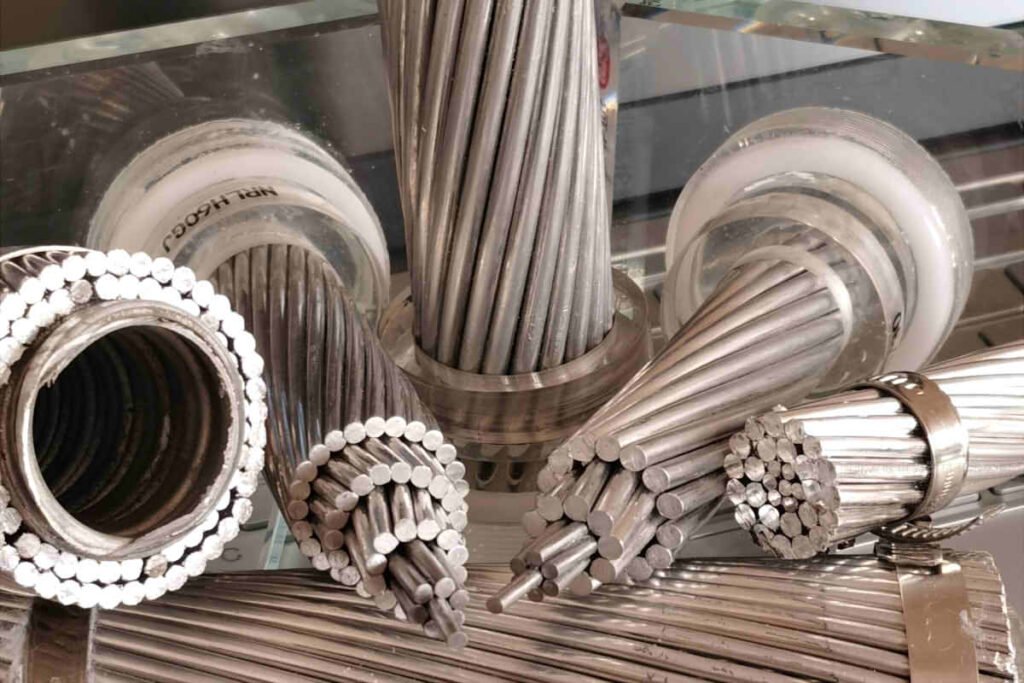
เรียนรู้เพิ่มเติมเกี่ยวกับ สายเคเบิลเหนือศีรษะสำหรับระบบสุริยะ
สายสื่อสารส่งผลต่อความแม่นยำของการนับระบบผลิตพลังงานแสงอาทิตย์หรือไม่?
ในระบบผลิตไฟฟ้าพลังงานแสงอาทิตย์, บทบาทหลักของสายสื่อสารคือการส่งสัญญาณควบคุมและข้อมูลการตรวจสอบ, เช่น การส่งออกพลังงาน, สถานะของระบบ, สัญญาณเตือนความผิด, และข้อมูลอื่นๆ. สายเคเบิลเหล่านี้ไม่ได้มีส่วนร่วมในการส่งพลังงานไฟฟ้าโดยตรง. ดังนั้น, สายเคเบิลสื่อสารเองไม่ได้ส่งผลโดยตรงต่อความแม่นยำของการนับในระบบผลิตพลังงานแสงอาทิตย์.
อย่างไรก็ตาม, หากสายสื่อสารเกิดข้อผิดพลาด (เช่นการลดทอนสัญญาณ, การรบกวน, หรือขาดการเชื่อมต่อ), อาจทำให้ระบบติดตามไม่สามารถรับหรือส่งข้อมูลได้อย่างแม่นยำ, จึงส่งผลต่อความเที่ยงตรงและทันเวลาในการตรวจสอบระบบ. ตัวอย่างเช่น, การส่งข้อมูลล่าช้าหรือผิดพลาดอาจทำให้เจ้าหน้าที่ซ่อมบำรุงไม่สามารถเข้าใจสถานะการทำงานที่แท้จริงของระบบผลิตไฟฟ้าได้ทันที หรือนำไปสู่การบันทึกข้อมูลที่ไม่ถูกต้อง, จึงส่งผลกระทบต่อสถิติและการวิเคราะห์การผลิตไฟฟ้า.
ดังนั้น, ในขณะที่สายสื่อสารไม่ส่งผลกระทบต่อการผลิตพลังงานไฟฟ้าจริง, สิ่งเหล่านี้มีความสำคัญอย่างยิ่งต่อการจัดการและการบำรุงรักษาระบบอย่างมีประสิทธิผล. สิ่งนี้เกี่ยวข้องทางอ้อมกับการประเมินประสิทธิภาพโดยรวมและการเพิ่มประสิทธิภาพของระบบผลิตพลังงานแสงอาทิตย์. การรับรองคุณภาพและการบำรุงรักษาสายเคเบิลสื่อสารอย่างเหมาะสมถือเป็นสิ่งสำคัญสำหรับการรักษาการตรวจสอบที่เชื่อถือได้และการทำงานที่มีประสิทธิภาพของระบบผลิตพลังงานแสงอาทิตย์.
เรียนรู้เพิ่มเติมเกี่ยวกับ สายไฟสื่อสารและควบคุมสำหรับระบบ PV
ข้อกำหนดทางกฎหมายและข้อบังคับสำหรับการเดินสายเคเบิลในโครงการพลังงานแสงอาทิตย์
ทำความเข้าใจการปฏิบัติตามกฎระเบียบ
เมื่อวางแผนและดำเนินโครงการพลังงานแสงอาทิตย์, จำเป็นต้องปฏิบัติตามข้อกำหนดทางกฎหมายและข้อบังคับต่างๆ เพื่อความปลอดภัย, ประสิทธิภาพ, และการปฏิบัติตามท้องถิ่น, ระดับชาติ, และมาตรฐานสากล. หน่วยงานกำกับดูแลและนโยบายควบคุมการติดตั้งและการทำงานของระบบพลังงานแสงอาทิตย์, รวมถึงการกำหนดเส้นทางและการเลือกสายเคเบิล. การทำความเข้าใจข้อกำหนดเหล่านี้มีความสำคัญอย่างยิ่งต่อการบรรลุผลสำเร็จของโครงการพลังงานแสงอาทิตย์ของคุณ.
หน่วยงานกำกับดูแลและมาตรฐานที่สำคัญ
รหัสไฟฟ้าแห่งชาติ (เอ็นอีซี)
ในประเทศสหรัฐอเมริกา, รหัสไฟฟ้าแห่งชาติ (เอ็นอีซี) กำหนดมาตรฐานการติดตั้งสายไฟและอุปกรณ์อย่างปลอดภัย. บทความ 690 ของ NEC กล่าวถึงโซลาร์เซลล์แสงอาทิตย์โดยเฉพาะ (พีวี) ระบบ, ครอบคลุมประเด็นต่างๆ เช่น วิธีการเดินสายไฟ, สายดิน, และการป้องกันกระแสเกิน. การปฏิบัติตามหลักเกณฑ์ของ NEC ช่วยให้มั่นใจได้ว่าการเดินสายเคเบิลของคุณเป็นไปตามมาตรฐานความปลอดภัยและประสิทธิภาพ.
คณะกรรมาธิการไฟฟ้าเทคนิคระหว่างประเทศ (ไออีซี)
คณะกรรมาธิการไฟฟ้าเทคนิคระหว่างประเทศ (ไออีซี) พัฒนามาตรฐานสากลด้านไฟฟ้าทุกประเภท, อิเล็กทรอนิกส์, และเทคโนโลยีที่เกี่ยวข้อง. ไออีซี 62548:2016 ให้แนวทางในการออกแบบและติดตั้งแผงเซลล์แสงอาทิตย์ PV, รวมถึงการจัดการสายเคเบิลและการกำหนดเส้นทาง. การปฏิบัติตามมาตรฐาน IEC มักจำเป็นสำหรับโครงการระหว่างประเทศ.
รหัสอาคารท้องถิ่น
รหัสอาคารท้องถิ่นอาจกำหนดข้อกำหนดเพิ่มเติมสำหรับการติดตั้งพลังงานแสงอาทิตย์, รวมถึงการกำหนดเส้นทางสายเคเบิล. รหัสเหล่านี้อาจแตกต่างกันอย่างมากตามภูมิภาค, ดังนั้นจึงจำเป็นอย่างยิ่งที่จะต้องปรึกษากับหน่วยงานท้องถิ่นและรับรองการปฏิบัติตามกฎระเบียบที่เกี่ยวข้องทั้งหมด.
แนวทางปฏิบัติที่ดีที่สุดสำหรับการกำหนดเส้นทางสายเคเบิล
การติดฉลากและเอกสารที่เหมาะสม
ตรวจสอบให้แน่ใจว่าสายเคเบิลทั้งหมดมีป้ายกำกับอย่างถูกต้องและมีการดูแลรักษาเอกสารประกอบที่ครอบคลุม. ซึ่งรวมถึงไดอะแกรมของเส้นทางสายเคเบิล, ข้อมูลจำเพาะของสายเคเบิลที่ใช้, และบันทึกการตรวจสอบและการอนุมัติ. เอกสารที่เหมาะสมช่วยอำนวยความสะดวกในการปฏิบัติตามกฎระเบียบและลดความยุ่งยากในการบำรุงรักษาในอนาคต.
การใช้ท่อร้อยสายและถาด
การใช้ท่อร้อยสายและถาดสายเคเบิลในการกำหนดเส้นทางสามารถป้องกันสายเคเบิลจากความเสียหายทางกายภาพได้, ลดความเสี่ยงของไฟฟ้าขัดข้อง, และเพิ่มความปลอดภัยโดยรวมในการติดตั้ง. ตรวจสอบให้แน่ใจว่าท่อร้อยสายและถาดเป็นไปตามมาตรฐานที่เกี่ยวข้องและได้รับการติดตั้งอย่างเหมาะสม.
การต่อลงดินและพันธะ
การต่อสายดินและการต่อสายดินอย่างเหมาะสมมีความสำคัญอย่างยิ่งต่อความปลอดภัยและประสิทธิภาพของระบบพลังงานแสงอาทิตย์. ตรวจสอบให้แน่ใจว่าวิธีการต่อลงดินเป็นไปตาม NEC, ไออีซี, และมาตรฐานท้องถิ่น. ซึ่งรวมถึงการใช้ตัวนำสายดินที่เหมาะสม, ขั้วต่อ, และแท่ง, และตรวจสอบให้แน่ใจว่าส่วนประกอบที่เป็นโลหะทั้งหมดได้รับการยึดเหนี่ยวอย่างเพียงพอ.
การตรวจสอบและบำรุงรักษาเป็นประจำ
การตรวจสอบและบำรุงรักษาเป็นประจำถือเป็นสิ่งสำคัญเพื่อให้แน่ใจว่าการเดินสายเคเบิลยังคงเป็นไปตามข้อกำหนดด้านกฎระเบียบและยังคงทำงานต่อไปได้อย่างปลอดภัยและมีประสิทธิภาพ. กำหนดเวลาการตรวจสอบเป็นระยะเพื่อระบุและแก้ไขปัญหาใดๆ, เช่นความเสียหายทางกายภาพ, สวมใส่, หรือการกัดกร่อน.
คำแนะนำที่จำเป็นสำหรับการซื้อสายเคเบิล
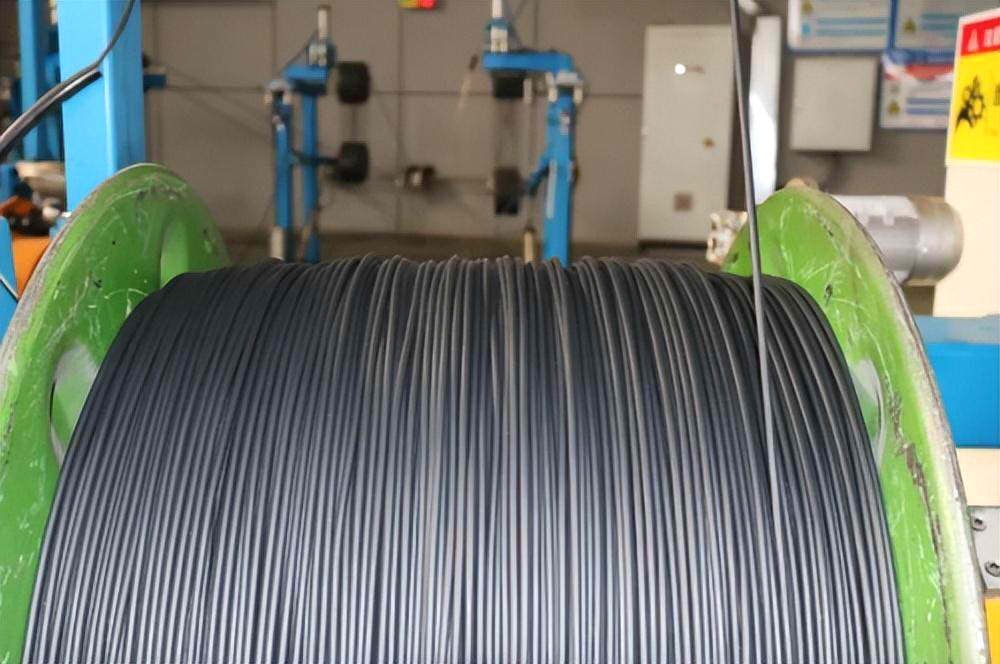
ทำความเข้าใจกับความต้องการของระบบของคุณ
ก่อนที่จะซื้อสายเคเบิล, การมีความเข้าใจที่ชัดเจนเกี่ยวกับความต้องการของระบบสุริยะของคุณเป็นสิ่งสำคัญ. พิจารณาขนาดของระบบ, ประเภทของส่วนประกอบที่ใช้, และสภาพแวดล้อม. ตรวจสอบให้แน่ใจว่าสายเคเบิลที่คุณเลือกสามารถรองรับโหลดไฟฟ้าที่คาดหวังได้ และเหมาะสมกับเงื่อนไขเฉพาะของสถานที่ติดตั้งของคุณ.
ให้ความสำคัญกับคุณภาพและการรับรอง
เลือกใช้สายเคเบิลคุณภาพสูงที่ได้รับการรับรองโดยมาตรฐานที่มีชื่อเสียง เช่น TÜV เสมอ, แอล, หรือไออีซี. สายเคเบิลที่ผ่านการรับรองได้รับการทดสอบเพื่อความทนทาน, ความปลอดภัย, และประสิทธิภาพ, มั่นใจได้ว่าเป็นไปตามมาตรฐานอุตสาหกรรม. การใช้สายเคเบิลที่ผ่านการรับรองจะช่วยป้องกันปัญหาที่อาจเกิดขึ้น เช่น การสูญเสียพลังงาน, ความร้อนสูงเกินไป, หรืออันตรายจากไฟไหม้.
เลือกประเภทสายเคเบิลที่เหมาะสม
เลือกสายเคเบิลที่ออกแบบมาสำหรับการใช้งานพลังงานแสงอาทิตย์โดยเฉพาะ. สำหรับการใช้งาน DC, สายเคเบิล PV เช่น H1Z2Z2-K และ PV1-F เหมาะอย่างยิ่งเนื่องจากมีความทนทานต่อรังสี UV, การเปลี่ยนแปลงของอุณหภูมิ, และความเครียดทางกล. สำหรับการใช้งาน AC, ตรวจสอบให้แน่ใจว่าคุณใช้สายเคเบิลแรงดันต่ำและปานกลางที่เหมาะสม.
พิจารณาปัจจัยด้านสิ่งแวดล้อม
คำนึงถึงสภาพแวดล้อม ณ สถานที่ติดตั้ง. สายเคเบิลที่สัมผัสกับสภาพอากาศที่รุนแรง, รังสียูวี, หรือควรเลือกอุณหภูมิที่สูงมากเพื่อให้ทนทานต่อสภาวะเหล่านี้. มาตรการป้องกันและฉนวนที่เหมาะสมจะช่วยยืดอายุการใช้งานของสายเคเบิลและรักษาประสิทธิภาพของระบบ.
ตรวจสอบให้แน่ใจว่าติดตั้งและบำรุงรักษาอย่างเหมาะสม
การติดตั้งที่เหมาะสมมีความสำคัญพอๆ กับการเลือกสายเคเบิลที่เหมาะสม. ปฏิบัติตามแนวทางปฏิบัติที่ดีที่สุดสำหรับการกำหนดเส้นทางสายเคเบิล, สายดิน, และการป้องกันเพื่อหลีกเลี่ยงความเสียหายทางกายภาพและความผิดพลาดทางไฟฟ้า. การบำรุงรักษาและการตรวจสอบเป็นประจำถือเป็นสิ่งสำคัญเพื่อให้มั่นใจถึงความปลอดภัยและประสิทธิภาพการทำงานของระบบพลังงานแสงอาทิตย์ของคุณอย่างต่อเนื่อง.
แผนการปฏิบัติตามกฎระเบียบ
ตระหนักถึงท้องถิ่น, ระดับชาติ, และกฎระเบียบระหว่างประเทศที่ใช้กับโครงการพลังงานแสงอาทิตย์ของคุณ. ตรวจสอบให้แน่ใจว่าการเลือกสายเคเบิลและการติดตั้งของคุณเป็นไปตามมาตรฐานเหล่านี้เพื่อหลีกเลี่ยงปัญหาทางกฎหมายและมั่นใจในความปลอดภัยและความน่าเชื่อถือของระบบของคุณ.
ความคิดสุดท้าย
การสละเวลาและทรัพยากรในการเลือกสายเคเบิลที่เหมาะสมสำหรับโครงการพลังงานแสงอาทิตย์ของคุณจะให้ผลตอบแทนในระยะยาว. สายเคเบิลคุณภาพรับประกันการส่งผ่านพลังงานอย่างมีประสิทธิภาพ, ลดต้นทุนการบำรุงรักษา, และเพิ่มความปลอดภัยและความน่าเชื่อถือโดยรวมของระบบของคุณ. โดยปฏิบัติตามแนวทางและแนวทางปฏิบัติที่ดีที่สุดที่ระบุไว้ในคู่มือนี้, คุณสามารถตัดสินใจได้อย่างมีข้อมูลซึ่งนำไปสู่ความสำเร็จในการติดตั้งพลังงานแสงอาทิตย์ของคุณ.
จดจำ, ระบบพลังงานแสงอาทิตย์ที่ได้รับการออกแบบมาอย่างดีไม่ใช่แค่แผงและอินเวอร์เตอร์เท่านั้น; สายเคเบิลที่เชื่อมต่อส่วนประกอบเหล่านี้มีความสำคัญเท่าเทียมกัน. อย่าลืมจัดลำดับความสำคัญด้านคุณภาพ, การปฏิบัติตาม, และการติดตั้งที่เหมาะสมเพื่อดึงศักยภาพสูงสุดของระบบพลังงานแสงอาทิตย์ของคุณ.

